Menus
- Naked bikes in comparison test
- Kawa delivers a refreshing performance
- What can the MV Agusta Brutale 800 RR?
- Soundscape like a hurricane
- And the Yamaha MT-09 SP?
- Title for the sportiest chassis goes to Italy
- Greatest racing feeling at the MV Agusta
- Less is sometimes more
- Conclusion
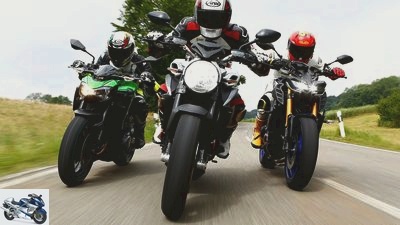
fact / Joachim Schahl

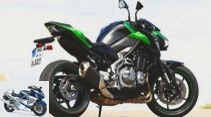
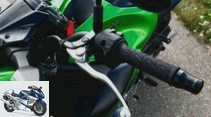
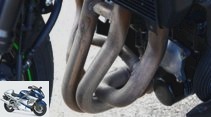
21st photos
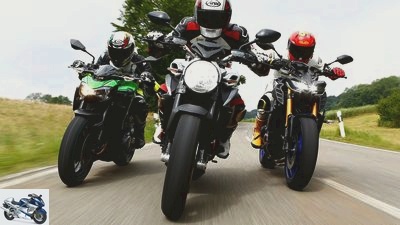
fact / Joachim Schahl
1/21
Kawasaki Z 900, MV Agusta Brutale 800 RR and Yamaha MT-09 SP promise undisguised driving pleasure that is potentially addictive. But which of the three nakeds has the edge after a wild day on the country road?
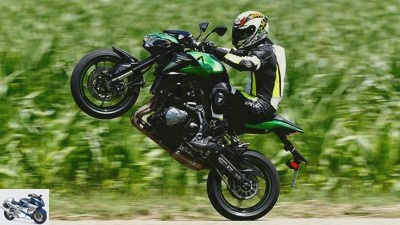
fact / Joachim Schahl
2/21
Kawasaki Z 900.
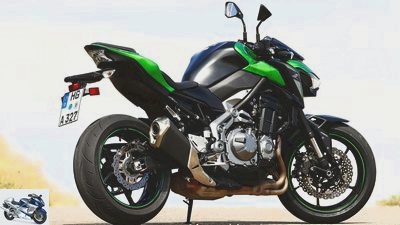
fact / Joachim Schahl
3/21
In recent years, Kawasaki has quite simply hardly built a motorcycle that is as lively and yet as uncomplicated as the Z 900.
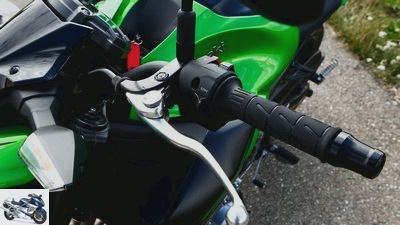
fact / Joachim Schahl
4/21
Super smooth clutch lever that is almost reminiscent of that of a motocross machine.
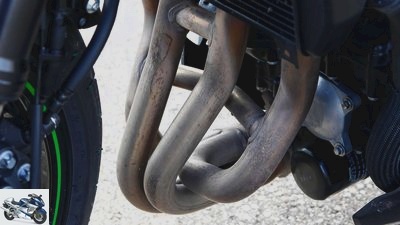
fact / Joachim Schahl
5/21
Artfully intertwined arrangement of the manifolds and interference pipes.
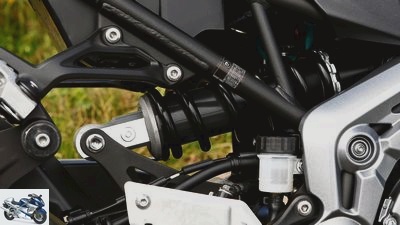
fact / Joachim Schahl
6/21
The suspension strut of the Z 900, which is linked by a lever system, offers an adjustable rebound stage. It is optimally accessible, but should be closed to almost one turn for sufficient damping.
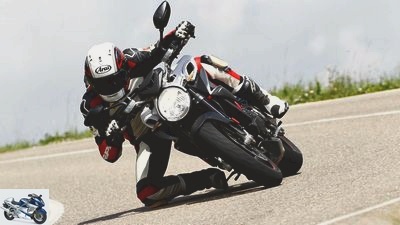
fact / Joachim Schahl
7/21
MV Agusta Brutale 800 RR.
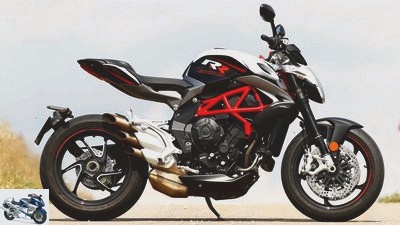
fact / Joachim Schahl
8/21
A soundscape like a hurricane.
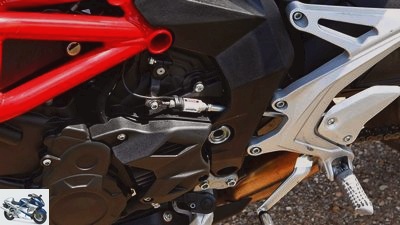
fact / Joachim Schahl
9/21
The Schaltassi changes gears up and down not very smoothly.

fact / Joachim Schahl
10/21
A normal screwdriver cannot be used to adjust the compression setting of the shock absorber because it is covered by part of the frame.
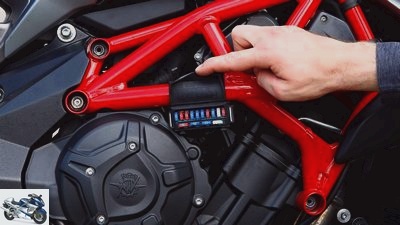
fact / Joachim Schahl
11/21
The fuses are easily accessible – and in the event of a fall on the right side, they are likely to be broken.

fact / Joachim Schahl
12/21
Yamaha MT-09 SP.
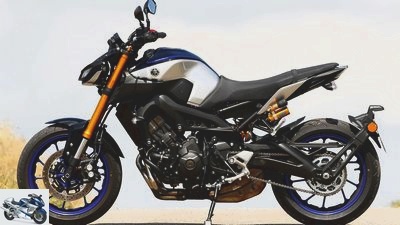
fact / Joachim Schahl
13/21
The SP is stable and at least retains the usual handiness of the series.
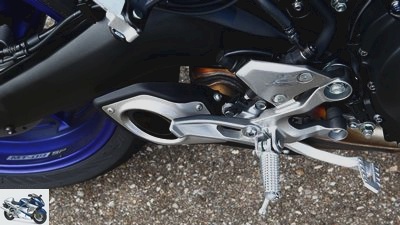
fact / Joachim Schahl
14/21
Only a measly exhaust pipe is hidden behind the attached cover – fake!
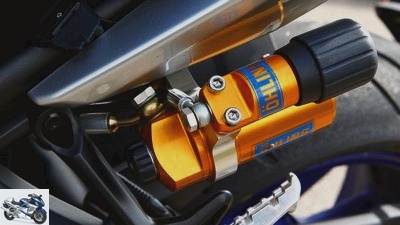
fact / Joachim Schahl
15/21
A fully adjustable Kayaba fork and an Ohlins shock absorber with remote adjuster (compression and preload) make the MT-09 an SP.
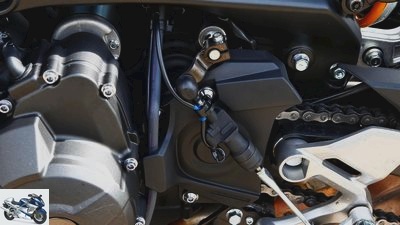
fact / Joachim Schahl
16/21
The design of the automatic switch looks like a handicraft box. It only works well above 4000 rpm, and it takes a long time to change gears.
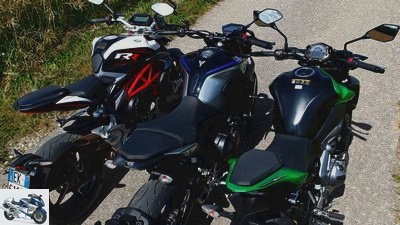
fact / Joachim Schahl
17/21
The MV Agusta beds its driver high up on a rock-hard seat cushion. With the Yamaha comfort is all the rage, the Kawa exaggerates with its deep seat.
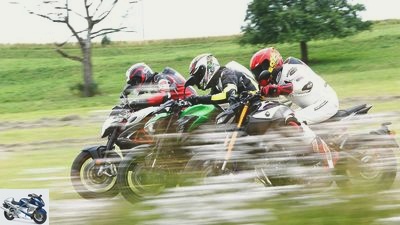
fact / Joachim Schahl
18/21
The three naked bikes in direct comparison.
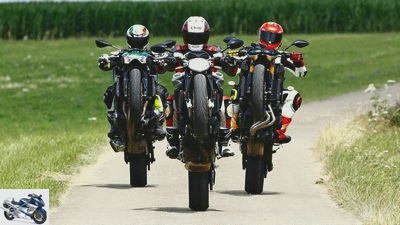
fact / Joachim Schahl
19/21
In the course of the comparison, there are differences in performance.
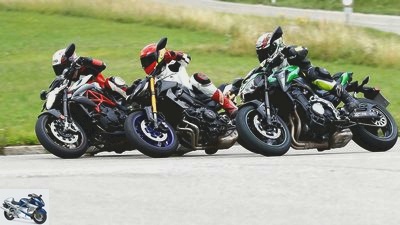
fact / Joachim Schahl
20/21
Speed down the country roads with the Brutale 800 RR, MT-09 SP and Z 900 – much better than any drive on congested motorways!
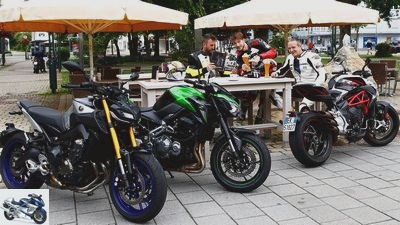
fact / Joachim Schahl
21/21
The last PS was something of 300km / h and motorway. However, these three actors here prefer the country road and enjoy (unleaded) after-work beer!
Kawasaki Z 900, MV Agusta Brutale 800 RR and Yamaha MT-09 SP
Naked bikes in comparison test
Content of
Kawasaki Z 900, MV Agusta Brutale 800 RR and Yamaha MT-09 SP promise undisguised riding fun that is potentially addictive. But which of the three nakeds has the edge after a wild day on the country road?
Happy holiday season! For many, the long holiday phase means finally being able to relax and recover again. However, this only applies to the part of the population that does not have a Kawasaki Z 900, M.V Agusta Brutale 800 RR or Yamaha MT-09 SP. The lucky owners of these nakeds, on the other hand, will know how to seize the opportunity and finally blow on the open country roads again while the others are stuck in traffic on the highways.
Buy complete article
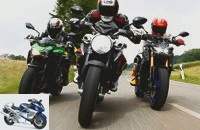
Kawasaki Z 900, MV Agusta Brutale 800 RR and Yamaha MT-09 SP
Naked bikes in comparison test
Kawasaki Z 900 presents
Once again, the Kawasaki Z 900 plays an important role in a test session. Its frequent occurrence is easy to explain: In recent years, Kawasaki has simply hardly built a motorcycle that is as lively and yet as uncomplicated as the Z 900. Of course, that needs to be clarified. Let’s start with the engine. Kawasaki does not quite stick to the model name 900 with the cubic capacity, but delivers a decent surcharge with real 948 cubic centimeters. Nobody can seriously complain about this, especially since the increased displacement of the machine gives the machine a powerful mid-rev range, from which the Z 900 fires again at around 8,000 rpm with a significant increase in power towards the limiter. The four-cylinder vibrates a bit around this mark, but never in a disturbing way.
fact / Joachim Schahl
The Kawa convinces with its uncomplicated and lively appearance.
On the contrary, the engine runs noticeably smoothly and meditatively smooth from operating temperature. Its nominal peak output of 125 hp does not stand up to a comparison with a superbike, of course. But the power is enough to accelerate furiously out of the corners in the curvy terrain and to sniff the short straights behind it. If the engine showed just a little more revving power, one would hardly fear much more powerful bikes. The Z 900 skilfully plays the role of the nimble hunter, but sometimes the driver thinks about the drive: “Come on, turn a little more!” Nothing to be done. With almost 10,000 tours, the end of the flagpole is reached.
Kawa delivers a refreshing performance
But back to the positive, such as the tuning of the Kawa engine. Softly and obediently, the four-of-a-kind takes on gas at medium to high speeds. The “Zett” follows its line neatly in the bend even when the driver directs the machine to another course with a throttle. Only at very low speeds does the Kawasaki briefly twitch roughly when the throttle valve should actually open softly. The fact that the Z 900 doesn’t have any different driving modes doesn‘t matter. Why also, when the engine is so well tuned? The sound design also deserves praise. Instead of roaring frenetically from the exhaust, the Z 900 entertains with a cheeky suction rattle that penetrates directly from the airbox into the driver’s ear canal. The Kawa delivers a refreshing performance, someone has to imitate it in this form first.
What can the MV Agusta Brutale 800 RR?
However, the MV Agusta Brutale 800 RR can beat the concise intake noise of the Z 900. With ease! The technicians from Varese recently brought the 800 RR up to the Euro 4 standard and in the process eliminated the wild exhaust shouting. The brutal does not sound particularly loud from its exhaust flute. But how hard she hisses at you from the airbox at full throttle is almost obscene and an experience in itself. Let’s stay with the topic of noises, because the MV organizes these in any form and timbre. Shortly after the 798 cubic centimeter three-cylinder comes to life, it makes rasping noises. A beet mill-like scraping that is quite likely caused by the hydraulic timing chain tensioner and settles again as soon as the oil pressure has built up. When standing, the MV Agusta growls dryly to itself.
fact / Joachim Schahl
The sound of the MV Agusta Brutale 800 RR is convincing.
In any case, the Edelross from Varese doesn’t really think much about running culture. But as soon as the area opens up in front of the front wheel and the empty country road asks you to finally pull the tap, all mechanical noises are drowned out in the acoustic turbulence of the intake system. Especially when the driver is still working a bit with his upper body in the bends and leans forward over the tank, there is the full boom! Working with the upper body works particularly well on what feels like the extremely short Brutale, because nothing comes directly in front of the handlebars other than a clear view of the asphalt.
Soundscape like a hurricane
In the medium speed range, the Italian triplet goes to work cautiously. If you miss punch, you’re right. Firstly, the MV has a longer gear ratio in the first three gears than the Z 900 and MT-09 SP. And secondly, our test bench finds only 129 of the promised 140 hp when measuring the performance. On the other hand, the three-cylinder, as an offshoot of the F3 racing engine, is still easy to turn and acts like a real sportsman from around 10,000 rpm – the machine wants to be kept in this area. So you always have the knife between your teeth more firmly than on the comparatively relaxing Japanese women, who grip harder from the middle.
fact / Joachim Schahl
Wheelies are not easy with the Brutale.
The triples’ greed for speed fits the character of the MV Agusta. As its model name suggests, there is nothing soft about the Brutale. Despite four different electronic driving modes, she never accelerates particularly smoothly. After a little trial and error, you always end up in the sport mode, because on “Normal” there is simply less life in the booth. In the middle speed range, however, the response is okay across all modes. Not that the brutal things would ruin the line when changing lean angles between two corners. But at lower speeds there are significant load changes because the engine does not follow the gas commands cleanly and directly enough. Beautiful wheelies, for example, are brutally difficult with the Brutale, because the engine should be fine-tuned for this. A pity!
And the Yamaha MT-09 SP?
Yamaha shows how it can be done better. The only difference between the MT-09 SP and the standard model is the fully adjustable chassis (Kayaba fork at the front, Ohlins strut at the rear) and the special SP paintwork, which makes a particularly high-quality impression. The electronics and the motor are identical to the standard model of the MT-09. The well-known three-cylinder engine with 847 cubic centimeters of displacement is controlled by different driving modes, just like on the MV Agusta: A, B and standard. Driving mode A is a tad too aggressive, B a tad too lax and Standard as a compromise just right in all cases
fact / Joachim Schahl
The engine of the Yamaha MT-09 SP has an output of 112 hp.
The example Z 900 shows, however, that it would be done with a single, properly coordinated program in this vehicle category. Even in standard mode, the MT-09 SP accelerates harshly at low speeds and from coasting mode. The rest of the presentation of the cultivated crossplane three-cylinder remains a stunner: The fat mid-rev range with a lot of lard shows the asthmatic triplet from MV Agusta how it should go. But the Yamaha engine also has larger individual cubic capacities than the Brutale. If you are looking for a fly in the ointment with the drive of the MT-09 SP, you will find it with the power measurement. With 112 hp, the engine remains just below the factory specification. In practice, the MT-09 SP delivers enough pressure on the country road, and although the Kawa four-cylinder has a whopping 15 hp more, the deep-sounding Yamaha three-cylinder feels more spectacular.
Title for the sportiest chassis goes to Italy
Time to finally bring the chassis into play. The SP variant of the MT-09 is, on the one hand, vastly superior to its standard version in this chapter. On the other hand, it does well in this test field. The standard MT-09 tends to be agitated at the front, pumps with the rear when accelerating out of an inclined position and even touches the footpegs because the shock absorber punctures.
fact / Joachim Schahl
The MV Agusta delivers the sportiest chassis.
The SP, on the other hand, is stable and at least retains the usual handiness of the series. The SP even drives as if on rails on perfectly flat asphalt. However, as soon as the ground becomes more wavy, the Kayaba fork proves to be less sensitive. The shock absorber, on the other hand, copes well with rough wrinkled asphalt and responds cleanly. The bottom line is that the MT-09 SP delivers a high level of driving comfort in any case, because the driver sits comfortably on the machine thanks to the relaxed knee angle. Compared to the Z 900 and the Brutale, the Yamaha feels like a kind of touring supermoto. It therefore does not quite achieve the accuracy of the Kawa and MV Agusta, and for very deep lean angles the SP also requires more pull on the handlebars than the competition.
Greatest racing feeling at the MV Agusta
The title for the sportiest chassis goes to the Brutale 800 RR with its torsionally rigid and cleanly welded tubular space frame. It conveys the greatest racing feeling by far. On the rock-hard seat upholstery you are enthroned significantly higher than on the comparatively touristy Japanese women. The driver feels quite inactive on the Z 900 and sits a good 40 millimeters lower than on the Brutale. The MV Agusta also has the shortest wheelbase of the trio at 1400 millimeters, the steepest steering head angle and a very short caster (the same as the Yamaha). These ingredients give the Brutale a nimble and sharp driving behavior.
fact / Joachim Schahl
The MV Agusta is the most expensive bike in this group test.
Nevertheless, it is difficult to circle evenly around the curve in an inclined position. If you feel it closely, you will feel that the machine is catching up with steering torque through the tires because the stiff chassis does not respond delicately enough. Despite all the enthusiasm for the sporty concept, some fans are giving up at this point. Co-test driver Ralf insists that a great chassis should work well and be comfortable. His conclusion on the MV chassis: “I’m too old for this sh ***.” Similar to the MT-09 SP, the Brutale cushions cleanly when standing and the spring elements show a fine breakaway torque – the damping actually feels soft . But when driving, the fork and strut respond as hard as a rock. With a measured negative spring travel of 30 millimeters at the rear, the sag is within the green range. We therefore suspect that the spring of the shock absorber is too hard and that the air / oil cushion on the fork may not fit.
Less is sometimes more
Things are less complicated with the Kawa. With simple components, it manages to display driving behavior that works well for sporty country road use with sufficient damping reserves. Your chassis only offers a rebound adjustment on the fork and shock absorber, which should be closed at least to one turn at the rear. Then the Z 900 lies tight enough without sacrificing driving comfort. The Z 900 hits corner entrances precisely, provides good feedback and a fine feel for the front wheel in an inclined position. The Z 900 rushes through bends with ease. The only thing you notice when changing lean angles is that the fork may come out of compression a little too quickly – a phenomenon that you can live with on most asphalt playgrounds.
fact / Joachim Schahl
Which bike will win the group test??
Finally, a word about electronics. A lot supposedly helps a lot, but a lot of cooks spoil the broth too. The Brutale 800 RR, for example, has various riding modes, only one of which is usable, an eight-stage traction control that has never worked properly and an automatic gearshift with a blipper function that shifts the gears roughly and hard when it does – from the second to at least not third gear. The automatic gearshift of the MT-09 SP also needs foot strength and takes a long time to change gears. And among the three different driving modes is one that works nicely. But good electronic tuning cannot cost a manufacturer like Yamaha with its vast wealth of experience and opulent database. Nothing against assistance systems, but when they are on board they should work properly. Especially when the purchase price of the bike is as high as that of the MV Agusta.
Conclusion
1.Yamaha MT-09 SP
The Yamaha took test victory, but not without a doubt. The great three-cylinder engine is still convincing, and the chassis finally fits. In terms of electronics, the switchability of the transmission and the brakes, the MT-09 does not set any highlights.
2. Kawasaki Z 900
Especially in relation to its low price, you can hardly blame the Z 900 for anything. The Kawa drives sporty and brilliant, only the low seat and the deep footrests disturb.
3rd MV Agusta Brutale 800 RR
The concept of the easy-turning three-cylinder in the ultra-handy chassis appeals to (almost) every full-throttle freak. Nevertheless, the customer gets a motorcycle for his money that does not seem to have been properly developed to the end. The rough engine remains well below its factory horsepower rating, and the way the electronics work is still immature.
Related articles
-
Comparison test: MV Agusta Brutale, Triumph Street Triple, KTM Super Duke
fact comparison test: MV Agusta Brutale, Triumph Street Triple, KTM Super Duke Three naked bikes in direct comparison There are motorcycles for which …
-
Comparison test Ducati Monster 821 Stripe, MV Agusta Brutale 800 and Yamaha XSR 900
r-photography.info 45 photos 1/45 Yamaha XSR 900. 2/45 MV Agusta Brutale 800. 3/45…
-
Yamaha Tracer 700 and Kawasaki Ninja 650 in comparison test
Arturo Rivas Yamaha Tracer 700 and Kawasaki Ninja 650 in the comparison test of mid-range sports tourers Some like it upright, others more …
-
Yamaha MT-09 and MV Agusta Brutale 800 in comparison test
bilski-fotografie.de 16 pictures bilski-fotografie.de 1/16 MV Agusta Brutale 800 and Yamaha MT-09. www.bilski-fotografie.de 2/16 Typical MV: Hybrid frame …
-
Comparison test Suzuki SV 650, Honda CB 650 F, Kawasaki ER-6n, Yamaha MT-07
www.bilski-fotografie.de 34 pictures www.bilski-fotografie.de 1/34 They are the hottest candidates among the middle class naked bikes ….
-
BMW F 800 R, Kawasaki Z 800, MV Agusta Brutale 800 and Yamaha FZ8 in the test
Jahn 29 photos Jahn 1/29 A comparison of four 800 class motorcycles: BMW F 800 R, Kawasaki Z 800, MV Agusta Brutale 800 and Yamaha FZ8. Jahn 2/29 Like…
-
Yamaha MT-09 Tracer, MV Agusta Stradale 800 and Triumph Tiger 800 XRx
fact 22 pictures fact 1/22 MV Agusta Stradale 800, Triumph Tiger 800 XRx and Yamaha MT-09 Tracer in a comparison test. fact 2/22 One for all: …
-
fact 30 pictures fact / Joachim Schahl 1/30 There is movement in the middle class. The Yamaha MT-09 is ready with a well-presented three-cylinder, which …
-
Jahn 35 pictures Jahn 1/35 Husqvarna TC 250 R in the motocross comparison test. Jahn 2/35 Yamaha YZ 250 F in the motocross comparison test. Jahn 3/35 Husqvarna TC …
-
Comparison test between Kawasaki ZX-6R and Kawasaki ZX-9R, Yamaha YZF-R6 and Yamaha R1
Artist Comparison test between Kawasaki ZX-6R and Kawasaki ZX-9R, Yamaha YZF-R6 and Yamaha R1 Attack from below Technically unchanged, the Kawasaki ZX-9R…